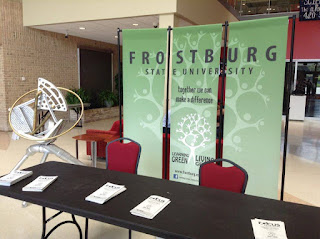On Thursday, April 20th, 2017, Frostburg State University students Kate Bickerstaff and Makayla Spencer organized a march for science that started at the clocktower in Frostburg. Professor Dr. Flood at Frostburg State helped promote and organize this event and there was a good turn out. Students and professors came out and marched together for one common goal.. Across the nation science programs for the government and school systems have been cut since President Donald Trump took office. The Bobcats for Science March will protest the censorship and defunding of science and related agencies occurring in today’s political atmosphere.
(Here is Makayla Spencer gathering people to start the march)
Kate and Makayla started the rally by thanking everyone for coming out on the nice day we were having and said jokingly "taking time out of their 4/20 events". They created signs for the people who joined the march and did not have their own. Dr. Flood was able to talk with me for a moment before the march and he was really passionate about the march. I asked her what made them want to start this march and he replied " The march for science really need more people representing thats why we are having one in Frostburg right before the one in Washington D.C". The march started at the clocktower and went all the way up and around the upper quad on campus at FSU. Also having drummers for the music department was a nice touch. The original plan was to march all the way to Main street in Frostburg but they decided to cut it short for the sake of the drummers.
 |
| (Everyone who participated in the march)
The team behind the Bobcats for Science march was able to get funding through the school to provide free transportation to the March for Science in Washington D.C on Saturday, April 22, 2017. The busses are leaving at 7am that morning from the parking lot by the Performing Arts Center on campus so they can get to D.C in time for the march. If you want to learn more about these marches for science click here. This march is sure to have a huge turn out not only because it is taking place in the nation's capital but it will also be Earth Day.
|












